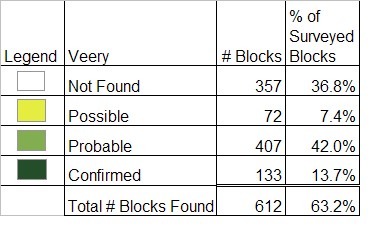Breeding Bird Atlases (BBA)
Find a Bird - BBA1
Breeding Bird Atlas 1 Species Accounts
Veery
Catharus fuscescens
Egg Dates
May 20 to June 30
Number of Broods
one or two

The Veery is a common forest bird. It ranges throughout most of Massachusetts but is more abundant in the western part of the state. Though the Veery is a “probable” nester on the Elizabeth Islands, it has not been recorded breeding on Martha’s Vineyard or Nantucket, is found only on the western part of Cape Cod, and is rare in southern Plymouth County. The species inhabits moist deciduous and coniferous woods, wooded swamps, thickets, and dry oak-pine woods.
Veeries arrive in Massachusetts during the first two weeks of May. During migration, this normally shy and solitary thrush is described as being quite tame and sometimes migrates in nocturnal flights made up of over a thousand individuals. Males may sing occasionally during migration but are generally silent for several days after reaching their nesting grounds. They sing throughout the day, but most intensively at dawn and dusk, and many observers know the Veery largely by the haunting song, four or five phrases descending in a spiral. A good rendition is da-vee-ur-vee-ur-veer-veer. The song period ends about the middle of July. The common call note is a sharp wheew. When the birds are agitated, they give a loud whuck and a screaming cry.
The nest is built in 6 to 10 days on the ground or in low shrubs or a brush pile. Of 5 Massachusetts nests, 3 were on the ground in open woodlands, 1 was on the ground at the edge of a path between dense woods and a gravel pit, and 1 was in a low thicket (Blodget, CNR). Rarely, nests are placed in trees, and there are old records for state nests 10 feet in an apple tree and 25 feet in a deciduous tree (ACB). The Veery constructs a bulky, coarse, well-concealed nest of twigs, weed stalks, and grapevines, lined with soft bark strips, rootlets, and grasses. If the ground is wet, a thick mat of leaves is often built as a base.
Clutches generally consist of three to five pale blue, unmarked eggs and for 6 Massachusetts nests were: two eggs (1 nest), three eggs (1 nest), four eggs (3 nests), five eggs (1 nest) (CNR, TC, DKW). The female incubates for 11 to 12 days, and the young are fed and defended by both parents. Brown-headed Cowbirds frequently parasitize Veery nests, and the host makes no attempt to remove the eggs but incubates them and raises the cowbird young. Some pairs raise two broods, but it is believed that many late nesting efforts are renesting attempts. One Massachusetts nest contained five young on June 9 (CNR). The young leave the nest 10 days after hatching. A pair in West Brookfield was observed feeding very small fledglings on June 15 (Meservey).
Veeries forage along the forest floor and in trees for snails, slugs, earthworms, and a variety of insects, including grubs, caterpillars, beetles, dragonflies, butterflies, and moths. Wild fruits such as blackberries, grapes, wild cherries, dogwood berries, Juneberries, and strawberries form a large percentage of their diet in certain seasons.
Fall migration begins in late August and is usually completed by mid-September. Wintering grounds extend from Central America to Brazil. The longevity record in the wild, based on recovery of a banded bird, is 9 years 11 months.
Map Legend and Data Summary
Atlas 1 data collected from 1975-1979


Note: common in moist deciduous and mixed woodlands; scarce or absent on the Cape and Islands
Elissa M. Landre



